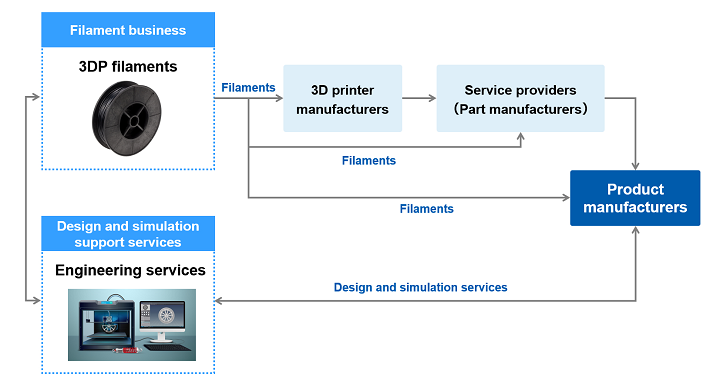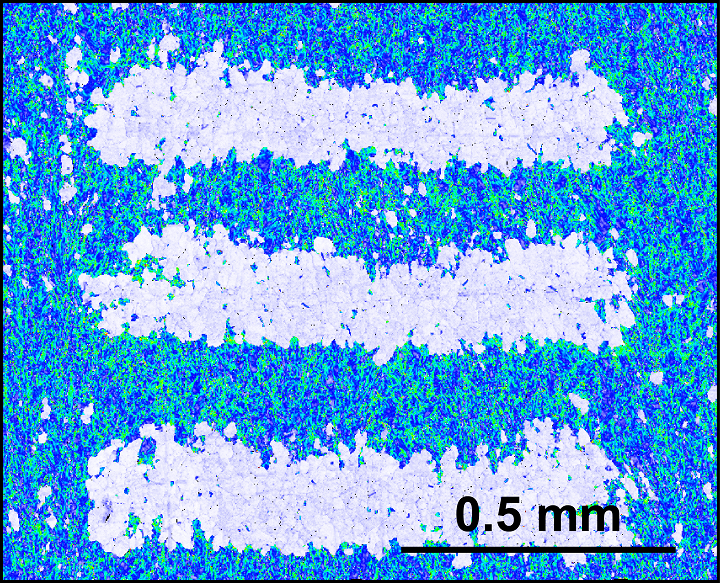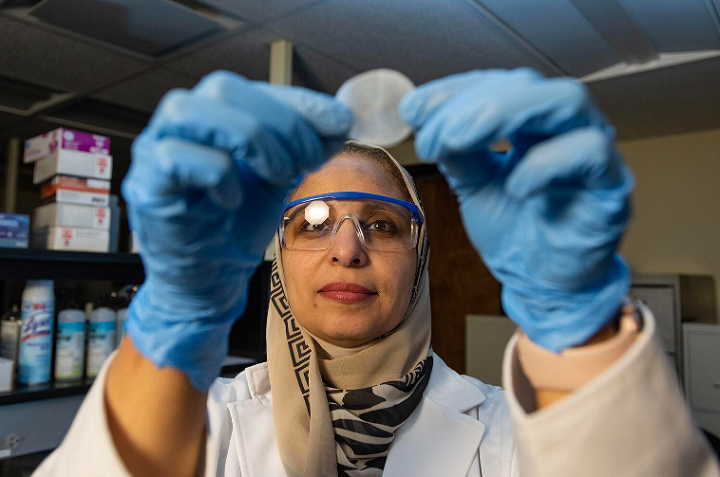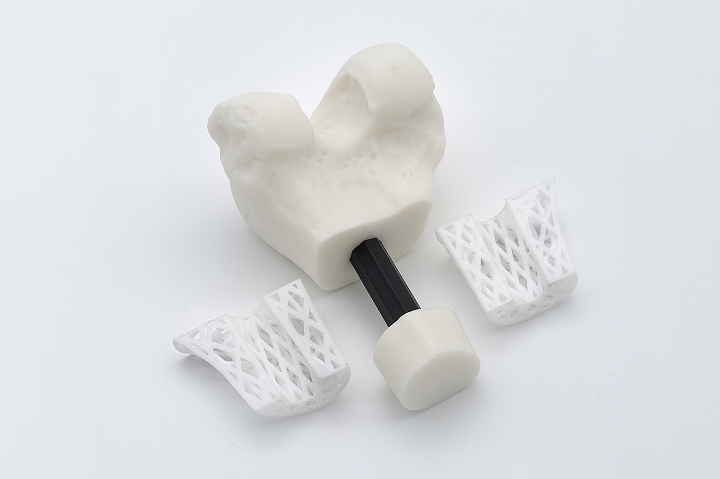We’re starting off with lots of materials news in today’s 3D Printing News Briefs, from Replique, Asahi Kasei, and Arkema; plus, a team of researchers are 3D printing metals with contrasting properties. Speaking of research, Georgia Tech researchers are using UV light, instead of high temperatures, to 3D print glass microstructures, while researchers from the University of Oxford are 3D printing neural cells that mimic brain architecture. Finally, a University of Mississippi research team developed a 3D printed film that supports cervical cancer research, and BellaSeno has a novel production workflow for customized, 3D printed bone scaffolds.
Replique Launches Open Material Database for AM at Formnext
 Replique’s material database speeds up the material selection process and provides access to collective material knowledge and resources to customers and service providers alike.
Replique’s material database speeds up the material selection process and provides access to collective material knowledge and resources to customers and service providers alike.At the recent Formnext 2023, Replique, which provides a decentralized 3D printing platform for secure reliable production of industrial-grade parts, announced the launch of a comprehensive, open material database for 3D printing. For AM projects to be successful, you need the right materials, but the research process for finding the right one is labor-intensive. Replique’s new database streamlines and simplifies material selection, offering users an intuitive platform—with support from its trusted material partners—that saves time and money. There are a variety of filtering options, such as industry standards, application fields, and technical specifications, and in the future, the platform will also provide quick access to reference cases and certificates. It’s an open system, so printer manufacturers, service providers, and end-users will all benefit, and can also contribute to the database with their own material insights.
“Through our daily engagement with material data, we have built a rich knowledge hub that we are now eager to share with the wider community,” explained Dr. Henrike Wonneberger, CEO and Co-Founder of Replique. “The launch of our material database represents another significant step in our mission to drive the industrialization of additive manufacturing and provide comprehensive support to our customers at every stage of their journey.”
Asahi Kasei Starts Sales for 3D Printing Filaments in North America
 Asahi Kasei’s filament business and design and simulation support services for 3D printing.
Asahi Kasei’s filament business and design and simulation support services for 3D printing.The Asahi Kasei Group, founded in 1922 and now boasting 48,000 employees worldwide, is expanding to the North American 3D printing market with filament sales through Asahi Kasei Plastics North America, Inc. (APNA), which manufactures high-performance, engineered polymers and chemically coupled polypropylene resins. APNA will advance two AM-focused business initiatives, starting with successful filament sales in North America and then a global expansion. The soft launch will start with filaments from the XYRON modified polyphenylene ether (mPPE) resin product line, with properties including heat resistance, impact strength, and printability, and then grow to include the Thermylene polypropylene (PP) group, which features creep and chemical resistance, high tensile strength, and elevated temperature performance.
APNA also has established computer-aided engineering (CAE) services, which have been expanded to 3D printing to offer support for filaments. In May, Asahi Kasei Corporate Venture Capital (CVC) invested in CASTOR Technologies to expand its CAE, and the two are now developing a unique 3D printing software, which includes automation of advanced simulations. So its second AM-focused business initiative will focus on customer support with advanced resources through CAE.
Arkema Partnering with AM Leaders to Develop Next-Gen Materials
To continue offering its customers more high-performance, sustainable 3D printing materials, like its bio-sourced Rilsan® Polyamide 11, Arkema has announced new partnerships with several industry leaders. At Formnext 2023, the group showcased its range of advanced 3D printing materials, including material solutions from its new partners. Together, Arkema and HP launched a new polyamide 12 powder for Multi Jet Fusion, called 3D High Reusability PA 12S, for production of functional parts, and the company also collaborated with GENERA on 3D printed personalized eyewear, using GENERA’s automated DLP process and Arkema’s N3xtDimension UV-curable material N3D-GEN976.
Arkema and Rapid Shape are working to push AM forward through a range of custom UV-curable N3xtDimension formulations tailored for high performance in the latter’s DLP printers, and the company is also continuing its journey with software provider 3YOURMIND to expand the Easy3D digital platform for advanced material recommendations and on-demand development; the key is adopting N3xtDimension liquid resins. EOS company Advanced Laser Materials is collaborating with Arkema to offer PEKK-100 powder—based on Kepstan PEKK—to EOS P810 users for use in demanding industries, like aeronautics. Finally, French service bureau Erpro 3D Factory developed an integrated supply chain in Europe for SLS 3D printed custom parts made with Arkema’s Pebax Rnew elastomers.
Researchers 3D Printing Customized Metal Parts with Different Properties
 A scanning electron microscope photo of a stainless steel part 3D printed using the new method developed by NTU Singapore and the University of Cambridge. The white regions of the metal part are mechanically weak, while the blue-green regions are strong. (Credit: NTU Singapore)
A scanning electron microscope photo of a stainless steel part 3D printed using the new method developed by NTU Singapore and the University of Cambridge. The white regions of the metal part are mechanically weak, while the blue-green regions are strong. (Credit: NTU Singapore)A team of researchers, led by the University of Cambridge and Nanyang Technological University, Singapore (NTU Singapore), came up with a new method to make customized 3D printed metal parts with different properties, like having some regions of metal parts stronger than others. Inspired by traditional “heating and beating” methods used in blacksmithing, the interdisciplinary team combined materials science, mechanical engineering principles, and 3D printing techniques normally used to remove and prevent defects in metals, and developed a method that can alter microscopic structures in the metals to change their properties. Additionally, the method makes it possible to decide what type of internal microstructure, and type of property, you want, and where it can be formed in the metal. Theoretically, manufacturers could use this process to design metal parts with features like different levels of corrosion resistance or electrical conductivity. You can learn more in the team’s research paper.
“Our method opens the way for designing high-performance metal parts with microstructures that can be finetuned to adjust the parts’ mechanical and functional properties, even at specific points, and allowing them to be shaped in complex ways with 3D printing,” explained Professor Gao, from NTU’s School of Mechanical and Aerospace Engineering (MAE).
Other scientists on the team were from the Agency for Science, Technology and Research (A*STAR)’s Singapore Institute of Manufacturing Technology (SIMTech); A*STAR’s Institute of High Performance Computing (IHPC); Switzerland’s Paul Scherrer Institut (PSI); the VTT Technical Research Centre of Finland; and the Australian Nuclear Science and Technology Organisation (ANSTO).
Georgia Tech 3D Printing Glass Microstructures with UV Light and Low Temperatures
 A 3D printed glass microfluidic channel, shown hollow and filled with liquid. Credit: Georgia Institute of Technology
A 3D printed glass microfluidic channel, shown hollow and filled with liquid. Credit: Georgia Institute of TechnologyInstead of relying on very high temperatures, researchers at the Georgia Institute of Technology (Georgia Tech) have developed a new process for 3D printing glass microstructures that uses fast ultraviolet (UV) curing. The method shortens curing time from 12 hours to five, and reduces the heat needed to convert printed polymer resin to silica glass from 1,100°C to around 220°C. Typically, 3D printing glass requires burning away polymer mixtures once the final shape is formed, but the team used a light-sensitive photoresin, based on soft PDMS, that’s converted to glass using deep UV light, which enables the lower temperatures that save heating energy. Plus, they don’t have to add silica nanoparticles, which means fewer resources are involved. As they explain in their research paper, the team’s process could be used print tiny glasses lenses for medical devices and imaging, as well as microfluidic devices and microelectronics with glass structures.
“This is one of the exploratory examples showing that it is possible to fabricate ceramics at mild conditions, because silica is a kind of ceramic. It is a very challenging problem,” explained George W. Woodruff School of Mechanical Engineering Professor H. Jerry Qi, who led the research. “We have a team that includes people from chemistry and materials science engaged in a data-driven approach to push the boundary and see if we can produce more ceramics with this approach.”
University of Oxford 3D Printing Neural Cells to Repair Brain Injuries
 Droplets containing human iPSC-derived neural progenitors were 3D printed to form 2-layer cerebral cortical tissue, which was cultured before implantation into a mouse brain slice. DNPs: deep-layer neural progenitors; UNPs: upper-layer neural progenitors. Image credit: Yongcheng Jin, University of Oxford.
Droplets containing human iPSC-derived neural progenitors were 3D printed to form 2-layer cerebral cortical tissue, which was cultured before implantation into a mouse brain slice. DNPs: deep-layer neural progenitors; UNPs: upper-layer neural progenitors. Image credit: Yongcheng Jin, University of Oxford.Brain injuries, caused by stroke, tumor surgery, and trauma, most often result in major damage to the outer layer of the brain, called the cerebral cortex, which causes difficulties with communication, cognition, and movement. Tissue regenerative therapies could one day help treat brain injuries, but until now, there hasn’t been a way to ensure that implanted stem cells mimic human brain architecture. But a study out of the Oxford Martin Programme on 3D Printing for Brain Repair could help change that: for the first time, researchers showed that neural cells can be 3D printed to mimic the architecture of the cerebral cortex, which is promising for repairing brain injuries.
The team made the cortical structure with human induced pluripotent stem cells (hiPSCs), which were differentiated into neural progenitor cells for two different layers of the cerebral cortex and suspended in solution to create two bioinks; these were used to print a two-layered brain tissue structure. When the printed tissue was implanted into mouse brain slices, the cells showed strong integration, as well as signaling activity, which indicates that the mouse and human cells were communicating. The researchers plan to refine their droplet printing technique further to make complex, multi-layered cerebral cortex tissues that can mimic the architecture of the human brain even more realistically.
Cervical Cancer Drug Delivery Options Could Improve with 3D Printed Film
 Eman Ashour, assistant professor of pharmaceutics and drug delivery, examines a 3D printed film developed by University of Mississippi researchers that could improve drug delivery options for cervical cancer patients.
Eman Ashour, assistant professor of pharmaceutics and drug delivery, examines a 3D printed film developed by University of Mississippi researchers that could improve drug delivery options for cervical cancer patients.(Photo courtesy of Thomas Graning, UM)
According to the Centers for Disease Control and Prevention, about 4,000 women die of cervical cancer each year in the U.S., and Mississippi has the second highest age-adjusted cervical cancer mortality in the nation, with 3.4 deaths per 100,000 women and girls a year. Researchers at the University of Mississippi (UM) are working to improve drug delivery of disulfiram, which shows promise as a cancer treatment. Most medications are oral, which can have absorption issues and side effects, but vaginal delivery is more targeted, and that’s what the team focused on in their research. They used hot-melt extrusion (HME), which involves melting a material and reshaping it while it cools, to produce drug-loaded filaments, and then 3D printed the precise dosage. Disulfiram is heat-sensitive, which could be problematic for vaginal delivery, so the team optimized the drug’s design, and the processing temperatures of HME, to create a film—enabling drug delivery directly to the target site.
“Vaginal drug delivery offers targeted, localized delivery. The vaginal film’s sticking properties help extend the film’s retention and the drug release, which is an added advantage,” said Eman Ashour, Assistant Professor of Pharmaceutics and Drug Delivery.
“The results of this user-inspired study will contribute to improving patient outcomes and treatment alternatives. “We hope to build new technologies based on this project’s success and explore other disease states and uses in the future.”
BellaSeno’s Production Workflow for 3D Printed Bone Scaffolds Presented
Finally, BellaSeno GmbH, a German medtech company, presented data about the novel workflow for its customized, 3D printed bone scaffolds at the German Congress of Orthopaedics and Traumatology (DKOU 2023). It’s one of the first companies to present an MDR-compliant (Medical Device Regulation) and ISO 13485 audited workflow for the design and production of custom, 3D printed, resorbable polycaprolactone (PCL) scaffolds for treating large (> 5cm size) segmental bone defects in conjunction with an autologous bone graft. With these types of injuries, scaffolds hold the bone graft in place for optimal healing and vascularization, and 3D printing enables the production of patient-specific ones. In BellaSeno’s workflow, 3D reconstruction is used to digitally segment the CT scan, and the company then follows the treating surgeon’s direction to create an anatomically-oriented design to fill the defect. After parameters are adjusted to customize the scaffold’s fit and mechanical performance, FDM technology is used to print a prototype, which is sent to a practitioner for “design freeze” and biomechanical testing. The final scaffold is manufactured under cleanroom conditions, and finished with post-processing and sterilization.
“This specific workflow allows a very time- and cost-effective manufacturing process for patient-specific scaffolds while complying with highest regulatory standards. Depending on the desired properties of the scaffolds, the products can absorb static non-deformable axial forces of up to 4,000 N or shorten by up to 1cm under a load of up to 1,000N in a controlled manner without breaking,” explained Dr. med. Tobias Grossner, Chief Medical Officer of BellaSeno. “This results in a new generation of high-performance bone scaffolds which are well suited for the biological reconstruction of large bone defects.”
Subscribe to Our Email Newsletter
Stay up-to-date on all the latest news from the 3D printing industry and receive information and offers from third party vendors.
Print Services
Upload your 3D Models and get them printed quickly and efficiently.
You May Also Like
The Market and Industry Potential of Multi-Material 3D and 4D Printing in Additive Electronics
Additive manufacturing leverages computer-based software to create components for products by depositing either dielectric or conductive materials, layer by layer, into different geometric shapes. Since its birth in the 1980s,...
3DPOD 262: Bio-inspired Design for AM with Dhruv Bhate, Arizona State University
Dhruv Bhate is an associate professor at Arizona State University. There, he looks at structures, materials, and design. Previously, he worked at PADT as well as in the semiconductor and...
3DPOD 261: Tooling and Cooling for AM with Jason Murphy, NXC MFG
Jason Murphy´s NXC MFG (Next Chapter Manufacturing) is not a generalist service; instead, the company specializes in making tooling. Using LPBF and binder jet, the company produces some of the...
3DPOD 260: John Hart on VulcanForms, MIT, Desktop Metal and More
John Hart is a Professor at MIT; he´s also the director of the Laboratory for Manufacturing and Productivity as well as the director of the Center for Advanced Production Technologies....


































